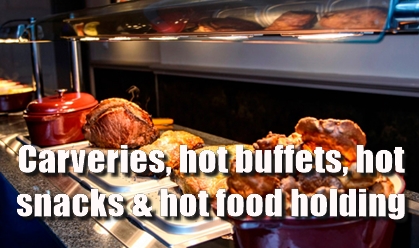Your Hazard Analysis and Critical Control Points (HACCP) regime will already make you aware that hot food must be kept above 63˚C. When you display hot food, e.g. on a buffet or carvery, you should use suitable hot holding equipment to keep it above 63˚C. See separate article on HACCP by clicking here .
If this is not possible, you can take food out of hot holding to display it for up to two hours. You can only do this once. After this time, you should either reheat the food until it is piping hot and put it back in hot holding, or chill it down as quickly as possible to 8˚C or below, or throw it away.
Remember to keep the food at a safe temperature until it is used. If you do take food out of hot holding to display it, remember not to mix new food with the food that is already on display. This could lead to the older food being left out for too long.
If a dish is not hot enough at any point during hot holding you can reheat it until it is piping hot and put back into hot holding (but only once) or chill down the food safely and reheat it later before serving. If you cannot do either of these things, throw the food away and remember that certain foods need extra care.
In most cases, the temperature of food can be checked using a probe thermometer. Ideally, a hand-held digital thermometer should be used when probing foods and checking temperatures. This may be supplemented by additional “in-place” thermometers which may be located in your hot holding equipment.
Warming cold food such as pies or sausage rolls or keeping food which has been freshly cooked at serving temperature needs careful food safety handling and the right equipment. It is not just about maintaining the heat to help keep the food safe to eat, but to keeping it fresh.
Dry heat will keep food warm, but if the food is likely to dry out, then dry heat will over a period of time fail reduce its quality. Food items such as cooked chicken will hold over a short period of time in a dry heat display cabinet, but are better stored in a cabinet that has a humidifier. “Wet” foods such as pasta dishes, or those with a high fat content such as pies and sausage rolls, will keep well in dry heat cabinets.
Food can also be held hot in serving dishes using underneath heat lamps or in chafing dishes which use spirit lamps for heat.
Snack warmer cabinets
These are not just warming cabinets, but display food being held to encourage sale. An attractive cabinet with good all-round vision and lighting in the cabinet will add to the appeal of the food.
If the cabinet is fitted with a humidifier, the foods in the cabinet will stay fresh and moist longer period than those is in a dry-heat cabinet. A humidifier can be something as simple as a built-in water trough which causes water vapour to be released into the cabinet.
Things to check on are to see if there is a feature on the unit which prevents misting up and doors on both sides can be useful in self-service situations, with food being loaded from the back and the customer taking from the front.
Hot cupboards
Traditionally, these are fixed units in the kitchen into which plated hot meals are stacked separated by a plate ring with a top cover on top to help prevent drying out.
Mobile hot cupboards are much more versatile with their castors with a brake mechanism.
The shelving arrangement can be flexible, with many shelves to take single plates or to use the stacking system. Gastronorm size compatibility is useful for keeping batches of food warm.
The top can be a solid work surface or have dry or wet heated bains marie so that things such as gravy, soups or custard can held.
Ease of cleaning is an important consideration as food debris not cleaned away is a serious food hygiene risk. You can get a range of accessories for hot cupboards that include tray slides, sneeze screens and digital temperature display.
Continue reading … page 2
